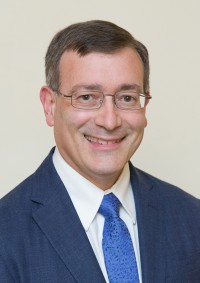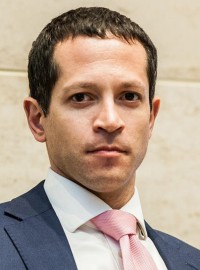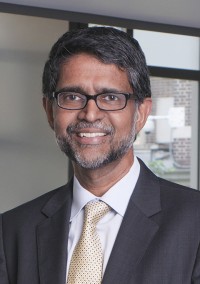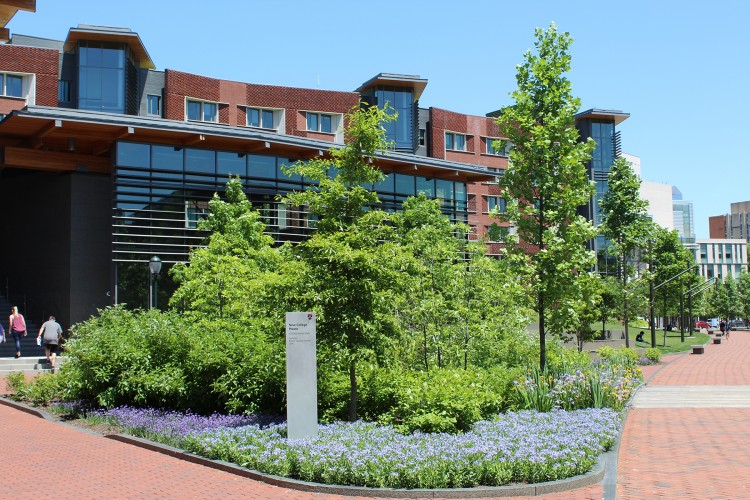FDA Approves CAR T Therapy for Large B-Cell Lymphoma Developed at University of Pennsylvania

 The U.S. Food and Drug Administration (FDA) has expanded approval for a personalized cellular therapy developed at the University of Pennsylvania’s Abramson Cancer Center, this time for the treatment of adult patients with relapsed or refractory large B-cell lymphoma after two or more lines of systemic therapy. This approval includes treatment of diffuse large B-cell lymphoma (DLBCL)—the most common form of non-Hodgkin’s lymphoma (NHL)—as well as high-grade B-cell lymphoma and DLBCL arising from follicular lymphoma. The approval was granted to Novartis for the chimeric antigen receptor (CAR) T-cell therapy Kymriah® (tisagenlecleucel, formerly CTL019), making it the second indication for the nation’s first personalized cellular therapy for cancer.
The U.S. Food and Drug Administration (FDA) has expanded approval for a personalized cellular therapy developed at the University of Pennsylvania’s Abramson Cancer Center, this time for the treatment of adult patients with relapsed or refractory large B-cell lymphoma after two or more lines of systemic therapy. This approval includes treatment of diffuse large B-cell lymphoma (DLBCL)—the most common form of non-Hodgkin’s lymphoma (NHL)—as well as high-grade B-cell lymphoma and DLBCL arising from follicular lymphoma. The approval was granted to Novartis for the chimeric antigen receptor (CAR) T-cell therapy Kymriah® (tisagenlecleucel, formerly CTL019), making it the second indication for the nation’s first personalized cellular therapy for cancer.
DLBCL affects approximately 30 percent of patients with NHL, and there are an estimated 27,000 newly diagnosed cases of DLBCL in the U.S. each year. About 6,500 of those patients have relapsed or refractory disease after two or more therapies and may now be eligible for Kymriah.
“This is an exciting event—seeing this lifesaving therapy become available widely to a large patient population with an unmet medical need,” said Stephen J. Schuster, the Robert and Margarita Louis-Dreyfus Professor in Chronic Lymphocytic Leukemia and Lymphoma Clinical Care and Research and director of the Lymphoma Program at Penn’s Abramson Cancer Center. “Many lives may be saved.”
In August 2017, Kymriah became the first therapy based on gene transfer ever approved by the FDA when it was authorized for children and young adults with relapsed or refractory B-cell precursor acute lymphoblastic leukemia (ALL). The FDA’s action is the latest accomplishment in the alliance between Penn and Novartis, which entered into a global collaboration in 2012 to further research, develop and commercialize Kymriah and other CAR T-cell therapies for the treatment of cancers.
Investigators at Penn’s Perelman School of Medicine who led research, development and clinical trials of CAR T therapy, in collaboration with Novartis, called this approval a massive step with potentially life-saving implications for patients.
Dr. Schuster led two studies examining CAR T therapy in DLBCL, including research published in the New England Journal of Medicine detailing long-term follow-up of the first cohort of these patients treated with the therapy at Penn and the global, multi-center, Novartis-sponsored trial known as JULIET. At the 59th American Society of Hematology (ASH) annual meeting, the data presented from the JULIET trial showed an overall response of 53 percent, with 40 percent of patients achieving a complete response, among the 81 infused patients with three or more months of follow-up or earlier discontinuation. At six-month analysis, the median duration of response was not reached.
“We’re proud to have developed this therapy through all phases of development and clinical trials right here at Penn and in collaboration with Novartis,” said Carl June, the Richard W. Vague Professor in Immunotherapy in the department of pathology and laboratory medicine in the Perelman School of Medicine and director of the Center for Cellular Immunotherapies in the Abramson Cancer Center.
Kymriah will be available through a network of certified treatment centers throughout the United States, including the Hospital of the University of Pennsylvania.
The treatment modifies patients’ own immune T cells, which are collected and reprogrammed at the Novartis manufacturing facility to potentially seek and destroy the patients’ lymphoma cells. Once they are infused back into patients’ bodies, these newly built cells both multiply and attack, targeting cells that express a protein called CD19. Tests reveal the army of hunter cells can grow to more than 10,000 new cells for each single engineered cell patients receive—producing durable remission rates in refractory lymphoma—and can survive in the body for years.
“Our collaboration with Penn has delivered Kymriah, a transformational therapy and first CAR T to be approved, initially for pediatric and young adult patients with ALL and today for adult patients with DLBCL,” said Liz Barrett, CEO, Novartis Oncology. “We are grateful to Penn for their leadership and to the courageous patients who participated in the clinical trials that have advanced Kymriah to be one of the most exciting technologies ever developed to fight cancer.”
Kymriah was first tested at Penn in 2010 in adult patients with advanced chronic lymphocytic leukemia (CLL). The first DLBCL trial, including double hit lymphoma, follicular lymphoma, and mantle cell lymphoma, opened at Penn in February 2014.
Many patients in the DLBCL trials experienced a side effect called cytokine release syndrome (CRS). CRS is a toxicity associated with CAR T therapy, which includes varying degrees of flu-like symptoms, with fevers, nausea and muscle pain, and can require ICU-level care. According to the data presented at ASH, 58 percent of patients in the DLBCL global study experienced CRS, including some who experienced moderate or severe toxicities. Twenty-one of those patients (26 percent) required treatment with tocilizumab, a therapy approved for CAR T cell-induced severe or life-threatening CRS, or corticosteroids. All of those patients recovered from their CRS. Other toxicities included infections (34 percent of patients), cytopenias or low blood count (36 percent), neurologic events (21 percent), febrile neutropenia (13 percent), and a metabolic abnormality called tumor lysis syndrome (one percent). All of the toxicities resolved on their own or with treatment, and there were no treatment-related deaths.
Novartis will create a registry to follow patients for 15 years after being treated to monitor their progress and any potential, future side effects.
The Novartis-Penn Center for Advanced Cellular Therapeutics (CACT) opened in 2016 and hosted Vice President Joe Biden at the launch of his Cancer Moonshot initiative, cementing Penn’s role as international innovator in the development and manufacturing of personalized cellular therapies.
Additional leaders of the DLBCL research include Jakub Svoboda, an assistant professor of hematology oncology, Daniel J Landsburg, an assistant professor of hematology oncology, and Sunita D. Nasta, an associate professor of hematology oncology.
Both of Dr. Schuster’s studies were supported by Novartis. The single-site trial was also supported by grants from the National Institutes of Health (1R01CA165206), as well as through philanthropic support for the Lymphoma Program at the Abramson Cancer Center of the University of Pennsylvania from James and Frances Maguire and the Frances Maguire Lymphoma Research Fund, Margarita Louis-Dreyfus and Sharyn Berman and the Richard Berman Family Funds for CLL and Lymphomas.
Patients who are interested in T-cell therapies at Penn Medicine can call (215) 316-5127 for more information.
Constantia Constantinou: Vice Provost and Director of Penn Libraries
 University of Pennsylvania Provost Wendell Pritchett recently announced the appointment of Constantia Constantinou as the H. Carton Rogers III Vice Provost and Director of the Penn Libraries, effective August 1.
University of Pennsylvania Provost Wendell Pritchett recently announced the appointment of Constantia Constantinou as the H. Carton Rogers III Vice Provost and Director of the Penn Libraries, effective August 1.
Ms. Constantinou will replace Mr. Rogers, who has led the Penn Libraries since 2004 and is retiring after a 43-year career at Penn.
“Constantia is a global leader in integrating the work of a large university library system with the wider academic mission of a university,” Provost Pritchett said. “In particular, she has been a pioneer throughout her career in developing digital, multimedia and technology initiatives in large university library systems and in advancing partnerships among libraries, museums and universities.”
For the past five years, Ms. Constantinou has been Dean of University Libraries at Stony Brook University of The State University of New York (SUNY), as well as a SUNY Distinguished Librarian. She was the Director of the Stephen B. Luce Library at SUNY-Maritime College the previous 12 years.
She created an ambitious strategic plan for the Stony Brook Libraries, redefining the libraries as a hub of collaboration in scholarly and digital initiatives and working with students, faculty, researchers and staff across the university, especially in developing the digital humanities, open access and a Center for Scholarly Communication.
Ms. Constantinou began her career at New York University’s Elmer Holmes Bobst Library and has brought her focus on digital and multimedia technology to leadership positions at the City University of New York, at Rutgers University Libraries, and as Director of the Helen T. Arrigoni Technology Library at Iona College.
Twice named a Fulbright Scholar, she is an active member of the global university library community, publishing articles and reviews, delivering conference presentations around the world, and serving in leadership positions for the Association of Research Libraries, Online Computer Library Catalogue, and International Federation of Library Associations, among others.
In addition, she is an accomplished classical guitarist who studied at the Royal School of Music in London before earning a bachelor’s degree in music and a master’s degree in music theory from Queens College of the City University of New York, where she also earned her master’s of library science degree.
“I am confident that Constantia will bring tremendous energy and vision to her work at the Penn Libraries, building on Carton’s legacy and collaborating with the many wonderful partners that she will meet across our university,” Provost Pritchett said. “I am grateful to the Board of Overseers, who has recognized Carton’s tenure with a generous gift that names the Directorship in his honor, and to the members of the ad hoc consultative committee who helped us arrive at this outstanding result.”
Penn Dental Medicine 2018 Teaching Awards
Penn Dental Medicine faculty/staff members were honored for excellence in teaching by the School’s graduating class of DMD students with the 2018 teaching awards. Each year, these awards are presented by students as part of Senior Farewell, an annual event that celebrates the passage of students to professional dentistry and welcomes them into the Penn Dental Medicine Alumni Society. This year’s event was held May 8 at The Bellevue in Center City Philadelphia. The awards and recipients included the following:
Basic Science Award

The Basic Science Award is presented for excellence in teaching within the basic sciences. This year’s recipient is Mel Mupparapu (D’96), professor of oral medicine and director of radiology. Dr. Mupparapu has been part of the School’s faculty for 13 years, presently teaching radiology and oral medicine in nine courses, including three for which he serves as course director. In addition, Dr. Mupparapu also directs the radiology honors program and the radiology fellowship program. In selecting the recipient of this award, the students noted, “The basic sciences are the cornerstone of our dental education and our teachers have fostered in us an appreciation of how clinical practice is continually advanced by the discoveries made at the bench.”
Robert E. DeRevere Award

The Robert E. DeRevere Award is presented for excellence in preclinical teaching by a part-time faculty member. The award is named in honor of Dr. DeRevere, a member of the Penn Dental Medicine Class of 1945, who served on the School’s faculty. This year’s recipient is Dr. Frank Smithgall (C’79, D’83), clinical associate professor of restorative dentistry, who has been a member of the School’s part-time faculty since 1984. Dr. Smithgall lectures in preclinical courses, and for the past four years, he has been course director of Partial Removable Dental Prosthesis. This is the fifth time Dr. Smithgall has been recognized with this award, also receiving it in 1990, 2010, 2011 and 2016.
Joseph L. T. Appleton Award

The Joseph L. T. Appleton Award is presented to a part-time faculty member for excellence in clinical teaching. This year’s recipient is Dr. Patrice Ierardi (MT’80, D’84), clinical assistant professor of restorative dentistry and assistant director of comprehensive care clinics. Dr. Ierardi joined the faculty in 2014, teaching clinical restorative dentistry on the clinic floor. Since taking on the role of assistant director of comprehensive care clinics last year, she has added to her teaching responsibilities with all DMD students throughout the predoctoral clinics. The Appleton Award is named in honor of Dr. Joseph Appleton, a 1914 alumnus of Penn Dental Medicine who served as dean of the School from 1941 to 1951. The award was founded in 1979 by Abram Cohen, a member of the Class of 1923 and father of Dean Emeritus D. Walter Cohen, Class of 1950.
Earle Bank Hoyt Award

The Earle Bank Hoyt Award is presented for excellence in teaching to a Penn Dental Medicine graduate who is a full-time junior faculty member. This award was established by a grateful patient in honor of Dr. Earle Bank Hoyt, a distinguished clinician and educator who was a member of the Class of 1918. This year’s recipient is Dr. Steven Wang (D’09, M’12, GD’15), Instructor in the department of oral & maxillofacial surgery/pharmacology. Dr. Wang completed his DMD and oral surgery training at Penn Dental Medicine, joining the School’s faculty in 2015. Dr. Wang is the director of the predoctoral oral surgery clinic, teaching students in the clinical setting on the fundamentals of oral surgery.
Senior Outstanding Teaching Award

The Senior Outstanding Teaching Award is presented to a faculty or staff member who has gone beyond the scope of his or her responsibilities to significantly impact the class’s education at Penn Dental Medicine. This year’s recipient is Art Kofman, C.D.T. quality control coordinator and the Office of Laboratory Affairs supervisor for the clinical labs at the School; this is the second year in a row that he was recognized with this award. Mr. Kofman has been sharing his knowledge and expertise in dental lab work with students as a member of the School’s staff for the past 17 years. Among his responsibilities, he coordinates students’ lab work from the School to commercial laboratories and vice versa, guides dental students in lab-related technical issues, and provides hands-on assistance as needed for minor adjustments to dental appliances at a chair-side setting.
Penn’s Human Capital Management Transformation Initiative invites the Penn community to join the team in a Town Hall meeting on June 7, from 1 to 2:30 p.m. at the Fitts Auditorium, Penn Law School. Registration is requested as space is limited: https://tinyurl.com/y99jg5w9
The Town Hall, focusing on Building the Future of Work at Penn will cover Workday@Penn, a cloud-based, integrated modern system that will replace many of the current systems that manage faculty affairs, human resources, payroll and other HCM-related processes.
- What is Workday@Penn?
- What does Workday@Penn look like?
- What does Workday@Penn do?
There will also be a a video demonstration, followed by Q&A. To submit a question: https://tinyurl.com/y7kg65ve
Executive sponsors and members of the Program Management Office will discuss the digital transformation and the impact on the campus community.
Learn about the success of the Penn Employee Solution Center, part of the people-centered services to provide consistent, up-to-date responses to the Penn community’s questions.
Planned Data Center Outage for August 4-5
ISC has scheduled a data center outage for Saturday, August 4. The 3401 Walnut Data Center, which houses a number of critical University applications and services, will be taken off-line for activities associated with the migration and decommissioning of the facility. It is expected that the full 48-hour maintenance window will be necessary: August 4, 12 a.m. through August 5, 11:59 p.m.
During this 48-hour maintenance window, please note:
- Clients potentially impacted by the outage will be contacted by the appropriate ISC service owner. The availability during the outage of a number of important and widely used applications and services will be posted at https://www.isc.upenn.edu/alerts-outages/planned-3401-walnut-data-center-outage-842018-852018 This list will be updated as we approach the outage date.
- Applications and services that will be taken off-line or that may experience brief disruptions will be dependent on their migration status. Clients should contact the appropriate ISC service owner for the migration status of their applications housed at 3401.
- Online mainframe applications and services that will not be available during the outage are: Payroll, Salary Management (SALMGMT), Student Financial Subsystems (SFSEASI), Student Aid Management (SAM, SAMS), Student Records System (SRS), Table and Data Dictionary (TADD). This is not a definitive list. Additional applications may be unavailable as we approach the outage date.
- All regularly scheduled production batch jobs and sequences will be held during this time.
Planned outages are required for maintenance of the technology infrastructure that supports University systems. Postponing these activities is not an option, as it carries the risk of an unplanned disruption that would require extensive emergency recovery time and could have severe consequences for service availability. While there is never a perfect time for the data center to be off-line, we have scheduled all outages for weekends and on dates that are the least disruptive to significant campus events in the University’s calendars.
As in similar outages, we ask that you do not schedule system-dependent events during this time.
ISC will hold two information sessions for the August outage. Look for details about the sessions, including registration, at https://www.isc.upenn.edu/alerts-outages/planned-3401-walnut-data-center-outage-842018-852018
For questions, contact your regular application support resource or Local Support Provider (LSP). If you don’t know who your LSP is, see https://www.isc.upenn.edu/get-it-help
Thank you for your patience and understanding as we continue to improve ISC services at Penn.
—Tom Murphy, Vice President of Information Technology & University Chief Information Officer, Information Systems & Computing
Penn Association of Senior and Emeritus Faculty (PASEF) 2017–2018 Annual Report
Overview
PASEF’s members are senior (age 55 and over) and retired standing faculty at Penn. Its mission is to organize programs and activities for its members and encourage them to continue to remain active in the intellectual and social life of the University and to provide service to the University and the community. A major function of PASEF is to assist senior faculty in their transition to retirement by providing retirement planning seminars and information.
PASEF was founded in 2004, and its current membership numbers approximately 900 senior faculty and 600 retired faculty. The Association of Senior and Emeritus Faculty (ASEF–PSOM) is an analogous organization for faculty at the Perelman School of Medicine. The two organizations each have their own Council, but they regularly cooperate in planning joint programs and activities, most recently through a newly established joint Program Committee.
PASEF is a member organization of AROHE, the Association of Retirement Organizations in Higher Education.
Administration
Governance and administration. PASEF operates under a set of bylaws and is governed by a Council which meets monthly during the academic year. The President, President-Elect, and Past President form the Steering Committee (Council members for 2017-2018 are listed in Appendix A).
PASEF receives an annual budget from the Provost and reports to Vice Provost for Faculty Anita Allen, who has been especially supportive. During the past year, excellent assistance has been provided by members of the Provost’s staff, including Jillian Powell, Julie Shuttleworth, and Kathy Swartz. We are also participating with the staff of the Provost’s Office on the redesign of our PASEF website.
Facilities. PASEF has an office in Duhring Wing, next to the office of the Faculty Senate. Staff support is provided by a half-time employee, the PASEF Coordinator, Sarah Barr. Through the efforts of Vice Provost Allen, PASEF has acquired a room adjacent to its current office which is now fully furnished and operational. Both the current office and the new space can accommodate meetings of small groups.
PASEF’s website is www.upenn.edu/emeritus
Retirement
PASEF and ASEF–PSOM provide resources and give presentations to aid senior faculty in planning their transition to retirement. During the past year four informational events were held, also receptions to recognize newly emeritus faculty.
Reception for newly emeritus faculty. Recently between 50 and 60 standing faculty have taken emeritus status each year, and PASEF and ASEF–PSOM have co-sponsored a reception in the Fall to honor the retirees.
This past year’s event in October 2017 was held at the Sweeten Center with Vice Provost Allen as the featured speaker. Attendance at the event was surprisingly low, due in large part to the fact that many AY 2017 retirees had already relocated. After discussions by both PASEF and ASEF Councils, a joint decision was made to shift the ceremony to the end of the spring semester 2018, initially as an experiment. Thus, a second retirement reception (with honorees’ photographs continually displayed on a large screen, and, again, with Vice Provost Allen as featured speaker) was held on May 16, 2018 (with much greater participation). If, as seems likely in view of the response to the spring ceremony, this scheduling turns out to be more popular, then the annual retirement reception for that year’s retirees will henceforth be held each May. The PASEF Council decided at its May 2018 meeting not to hold a retirees event in the fall.
Road to Retirement programs and Hitchhiker’s Guide. Each spring PASEF presents two Road to Retirement information programs and, with ASEF–PSOM, partners with Human Resources for a third presentation.
In March, a panel of senior and retired faculty spoke in the Van Pelt-Dietrich Library about their retirement decisions and experiences in emeritus status. The session included a presentation on continuing care retirement communities (CCRCs). PASEF proposes to hold a separate panel discussion on CCRCs in fall 2018.
In April, Hilary Lopez and Vicki Mulhern, University staff experts on retirement, discussed retirement options and the details of retiree benefits. Some 53 potential retirees attended the event (in Van Pelt-Dietrich Library), and many general and specific questions were addressed.
Representatives from Social Security and Medicare spoke in May at the event organized by Human Resources.
In January 2018 PASEF published the eleventh edition of its Hitchhiker’s Guide to Faculty Retirement under the able editorship of Martin Pring. Sections on financial planning for retirement, transition to emeritus status and retiree relations with the University are included, and the publication is available on the PASEF and ASEF–PSOM websites.
Activities and Events
Monthly lectures. PASEF sponsors lectures throughout the academic year. These are open to all members of the University community and span a wide range of topics of general interest. ASEF-PSOM also sponsors monthly lectures and two special lectures in fall and spring. This year PASEF’s Program Committee was jointly chaired by Paul Shaman and Jerry Porter. Further, a joint Program Committee for ASEF-PSOM and PASEF has also been established this year to coordinate the timing of joint events and lectures.
The PASEF Program Committee arranges eight monthly lectures and a featured lecture each semester. The Fall Lecture, given each year in October in conjunction with the 25-Year Club Dinner, was presented by Jane Golden, Director of Mural Arts Philadelphia (entitled “Public Art and Social Change”), and the Spring Lecture speaker was Kathleen Jamieson of the Annenberg School (How Russian Hackers and Trolls Exploited U.S. Media In 2016). In addition, the Library Committee (headed by Vivian Seltzer) arranged four lectures on a variety of topics.
Links to video recordings of some of the lectures are available on the PASEF website.
Outings. PASEF and ASEF-PSOM together organize two outings a year, one in the fall (organized by ASEF-PSOM), and another in the spring (organized by PASEF). In fall 2017 we visited the Hagley Museum in Wilmington, and in April there was a visit to the Michener Museum in Doylestown, where a guided tour took us through a special exhibit of works of the Wyeth family.
Membership initiatives. The Membership Committee, chaired by Anita Summers, presented several recommendations, which were approved by the Council. These include organization of special events such as attendance at concerts, which has been extremely popular and successful; reserving a table at the University Club where members can meet for lunch and conversation on a regular schedule, which has not, thus far, attracted a sufficient clientele; a second annual cultural outing in the fall (yet to be implemented); and additional planning for retirement presentations, including a special session devoted to CCRCs (the first of which is planned for fall 2018).
Community Involvement. Following up on an enthusiastic presentation by members of the Council concerning community involvement initiatives at the final meeting of the PASEF Council in May 2017, Ira Harkavy, the Director of Penn’s Netter Center, was invited to attend the PASEF Council’s September 2017 meeting. Members of the ASEF-PSOM Council also attended.
He described to us the various community-based initiatives in which the Center and members of the Penn faculty are currently involved. As a result of that meeting and the discussions that followed, a PASEF ad-hoc committee on community involvement, chaired by Joan Goodman, was established. The committee made regular presentations to subsequent PASEF Council meetings during the year, including results from its survey of member interest. In March 2018 it was proposed and accepted that the ad-hoc committee should become a standing committee, requiring a change to the PASEF by-laws. A resolution to that effect was passed at the May 2018 meeting.
Speakers Bureau. With encouragement and funding from Vice Provost Allen, PASEF launched its Speakers Bureau in the spring of 2016. This work was spearheaded by Jack Nagel as initial chair of the Speakers Bureau Committee; Roger Allen has since taken over as coordinator of the bureau’s activities. The Bureau enables community groups, including retirement communities, civic and religious organizations and high schools, to identify and invite PASEF members to speak to audiences in the Philadelphia area. The current roster of speakers numbers 25 and includes both senior and retired Penn faculty from Schools across the University. Information about the Bureau and the speakers and their topics is available on the PASEF website at www.upenn.edu/emeritus
Faculty Senate and University Council
For the last 10 years, PASEF has sent a non-voting representative to the Senate Executive Committee (SEC). After discussions last year, the Senate leadership granted PASEF non-voting membership on four Senate Committees, starting in 2016–2017. The committees are the Senate Committee on Faculty and the Administration; the Senate Committee on Faculty and the Academic Mission; the Senate Committee on Students and Educational Policy; and the Senate Committee on Faculty Development, Diversity, and Equity. PASEF also has a member on the University Council’s Committee on Personnel Benefits.
PASEF Annual Election
Gino Segrè chaired the AY2017-2018 PASEF Nominating Committee. The Committee’s proposed slate was approved by email voting following the March Council meeting.
James Ferguson was elected President-Elect, Paul Shaman Secretary, and Martin Pring the SEC Representative. New at-large Council members who will serve three-year terms are Marc Dichter, Joretha Bourjolly and Jorge Santiago-Avriles.
—Roger Allen, PASEF President (2017–2018)
Appendix A: PASEF Council Members, 2017-2018
Roger M.A. Allen, Professor Emeritus, Near Eastern Languages and Civilizations (SAS). President; Co-Chair, Speakers Bureau Committee
David Balamuth, Professor Emeritus, Physics and Astronomy (SAS), Representative to the University Council Committee on Personnel Benefits
Janet Deatrick, Professor Emerita, Family and Community Health (Nursing), at-large member
Lois Evans, Professor Emerita, Family and Community Health (Nursing), President-Elect
Murray Gerstenhaber, Professor Emeritus, Mathematics (SAS), at-large member
Joan F. Goodman, Professor Emerita, Literacy, Culture, and International Education (GSE), Chair, Ad-hoc Committee on Community Involvement
Howard I. Hurtig, Professor Emeritus, Neurology (PSOM), Secretary
John C. Keene, Professor Emeritus, City and Regional Planning (Design), Representative to the Faculty Senate Committee on Faculty Development, Diversity, and Equity
Walter Licht, Professor of History (SAS), at-large member
Ann Mayer, Associate Professor, Legal Studies and Business Ethics (Wharton), at-large member
Marshall W. Meyer, Professor Emeritus, Management (Wharton), Representative to the Faculty Senate Committee on Faculty and the Administration
Jack H. Nagel, Professor Emeritus, Political Science (SAS), Co-Chair, Speakers Bureau Committee
Gerald J. Porter, Professor Emeritus, Mathematics (SAS), Co-Chair, Program Committee
Martin Pring, Professor Emeritus, Physiology (PSOM), Representative to the Faculty Senate Executive Committee; Editor, Hitchhiker’s Guide to Retirement
Gino C. Segrè, Professor Emeritus, Physics and Astronomy (SAS), Representative to the Faculty Senate Committee on Faculty and the Academic Mission
Vivian C. Seltzer, Professor Emerita, Human Development and Behavior (SPP), Chair, Library Committee
Paul Shaman, Professor Emeritus, Statistics (Wharton), Past-President and Co-Chair, Program Committee
Anita A. Summers, Professor Emerita, Business Economics and Public Policy (Wharton), Chair. Membership Committee; Representative to Faculty Senate Committee on Students and Educational Policy
Past Presidents: Rob Roy MacGregor, Benjamin S. P. Shen, Neville E. Strumpf, Vivian Seltzer, Roger Allen, Ross A. Webber, Jack Nagel, Anita Summers
Penn Children’s Center: FY2019 Rates
Effective Monday, July 2, 2018, new rates at the Penn Children’s Center become effective. The rate structure for the 2018-2019 school year reflects the Center’s commitment to continue to provide high-quality care and programming in the most cost-effective manner possible. Accredited by the National Association for the Education of Young Children (NAEYC) and licensed by the State of Pennsylvania’s Department of Human Services (DHS), the Penn Children’s Center is open to all members of the University and surrounding communities with preference given to faculty, staff and students of the University. For more information, please visit www.upenn.edu/childcare

Penn Rate is available to Penn faculty, staff, students and UPHS employees.
Assisted Rates are for the University of Pennsylvania Faculty and Staff meeting eligibility requirements. Subject to space and funding. Assisted A rates apply to University faculty and staff only with combined family income below $62,000. Assisted B rates are for University faculty/staff only with combined family income below $74,000.
Important Tax Information: Under current applicable Internal Revenue Service (IRS) regulations, any subsidies for dependent care provided by the University of Pennsylvania must be reflected on your Form W-2 as employer-provided dependent care assistance. These subsidies are taken into account in determining the maximum annual exclusion for tax-free employer-provided dependent care assistance (currently $5,000 annually). This includes both the University discounted tuition rate and any direct fee reduction approved for eligible families. You will, therefore, want to take into consideration any University-provided subsidy for the Penn Children’s Center in determining your salary reduction election if you participated in the University’s Dependent Care Pre-Tax Expense Account Plan. The total amount of any subsidies and the total amount of your contributions to the Dependent Care Pre-Tax Expense Account cannot go over the annual limit of $5,000. Any amount over the IRS limit would have to be reflected on your W-2 as imputed income. If you have any questions concerning your spending account, you may contact the Penn Benefits Center at 1-888-PENNBEN (1-888-736-6236).

 The U.S. Food and Drug Administration (FDA) has expanded approval for a personalized cellular therapy developed at the University of Pennsylvania’s Abramson Cancer Center, this time for the treatment of adult patients with relapsed or refractory large B-cell lymphoma after two or more lines of systemic therapy. This approval includes treatment of diffuse large B-cell lymphoma (DLBCL)—the most common form of non-Hodgkin’s lymphoma (NHL)—as well as high-grade B-cell lymphoma and DLBCL arising from follicular lymphoma. The approval was granted to Novartis for the chimeric antigen receptor (CAR) T-cell therapy Kymriah® (tisagenlecleucel, formerly CTL019), making it the second indication for the nation’s first personalized cellular therapy for cancer.
The U.S. Food and Drug Administration (FDA) has expanded approval for a personalized cellular therapy developed at the University of Pennsylvania’s Abramson Cancer Center, this time for the treatment of adult patients with relapsed or refractory large B-cell lymphoma after two or more lines of systemic therapy. This approval includes treatment of diffuse large B-cell lymphoma (DLBCL)—the most common form of non-Hodgkin’s lymphoma (NHL)—as well as high-grade B-cell lymphoma and DLBCL arising from follicular lymphoma. The approval was granted to Novartis for the chimeric antigen receptor (CAR) T-cell therapy Kymriah® (tisagenlecleucel, formerly CTL019), making it the second indication for the nation’s first personalized cellular therapy for cancer.
 University of Pennsylvania Provost Wendell Pritchett recently announced the appointment of Constantia Constantinou as the H. Carton Rogers III Vice Provost and Director of the Penn Libraries, effective August 1.
University of Pennsylvania Provost Wendell Pritchett recently announced the appointment of Constantia Constantinou as the H. Carton Rogers III Vice Provost and Director of the Penn Libraries, effective August 1. 





.jpg) Susan Brozena, an emeritus associate professor of cardiovascular medicine in the Perelman School of Medicine, is the recipient of the 2018 Lifetime Achievement Award from the American Heart Association. This award celebrates a professional who has had a pioneering career and has made an exceptional impact on their patients, the Philadelphia community and cardiology.
Susan Brozena, an emeritus associate professor of cardiovascular medicine in the Perelman School of Medicine, is the recipient of the 2018 Lifetime Achievement Award from the American Heart Association. This award celebrates a professional who has had a pioneering career and has made an exceptional impact on their patients, the Philadelphia community and cardiology. Marybeth Gasman, the Judy and Howard Berkowitz Professor of Education and the director of the Penn Center for Minority Serving Institutions (MSIs), was awarded the Dr. Carlos J. Vallejo Memorial Award for Lifetime Scholarship by the Multicultural/Multiethnic SIG of the American Educational Research Association.
Marybeth Gasman, the Judy and Howard Berkowitz Professor of Education and the director of the Penn Center for Minority Serving Institutions (MSIs), was awarded the Dr. Carlos J. Vallejo Memorial Award for Lifetime Scholarship by the Multicultural/Multiethnic SIG of the American Educational Research Association. Michael C. Horowitz, professor of political science and the associate director of Perry World House, will lead a research team that has been awarded a $1.04 million grant from the Air Force Office of Scientific Research, through the Department of Defense (DoD) Minerva Initiative, for a project titled “The Disruptive Effects of Autonomy: Ethics, Trust and Organizational Decision-Making.”
Michael C. Horowitz, professor of political science and the associate director of Perry World House, will lead a research team that has been awarded a $1.04 million grant from the Air Force Office of Scientific Research, through the Department of Defense (DoD) Minerva Initiative, for a project titled “The Disruptive Effects of Autonomy: Ethics, Trust and Organizational Decision-Making.” Vijay Kumar, the Nemirovsky Family Dean of the School of Engineering and Applied Science, has been elected to the American Philosophical Society. Founded by Benjamin Franklin in 1743 for the purpose of “promoting useful knowledge,” the society is the oldest learned society in the United States, continuing its founder’s spirit of inquiry by providing a forum for the free exchange of ideas.
Vijay Kumar, the Nemirovsky Family Dean of the School of Engineering and Applied Science, has been elected to the American Philosophical Society. Founded by Benjamin Franklin in 1743 for the purpose of “promoting useful knowledge,” the society is the oldest learned society in the United States, continuing its founder’s spirit of inquiry by providing a forum for the free exchange of ideas.










